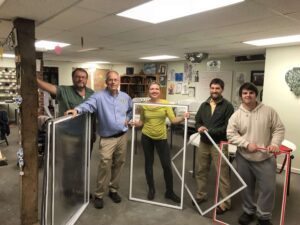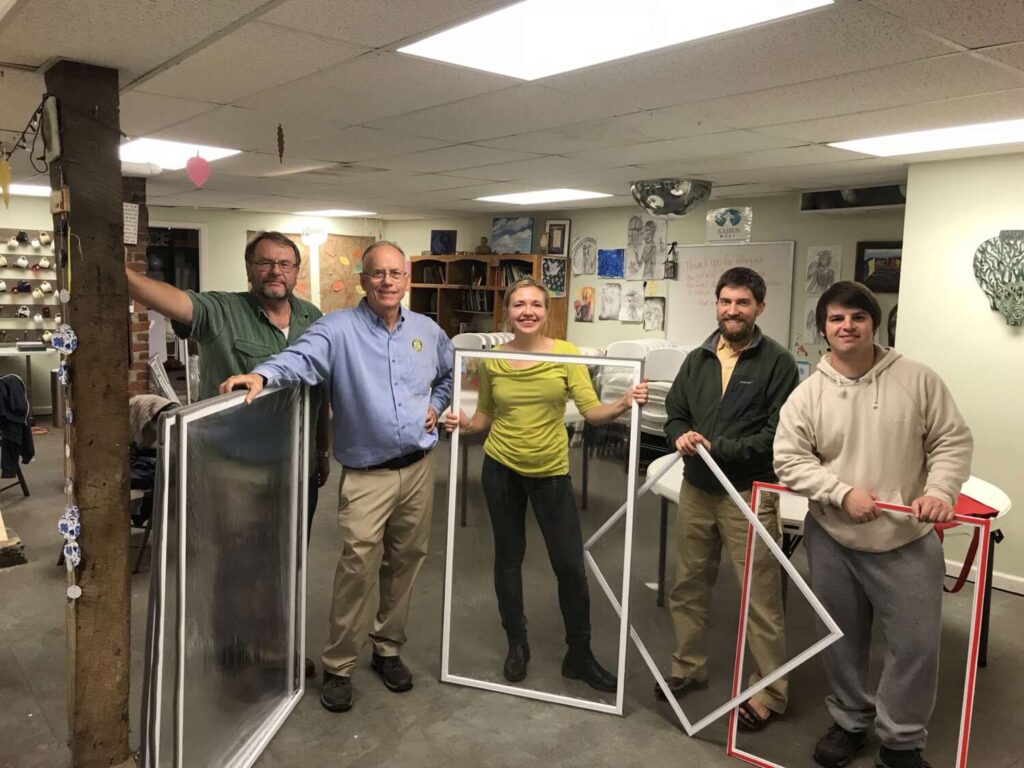Editor’s note: The earliest days of our nonprofit’s Energy Savers Network program are remembered by co-founder Brad Rouse in this excerpt from his new book, “Climate Warrior: Climate Activism and Our Energy Future.”
Energy Savers Network’s first client, Maria, was a joy to help.
We patched numerous holes and put in a new back door on her home. She had some extra insulation that she bought to install under her floor. We also discovered some leaky windows, and ordered some interior storm window inserts for her home.
Maria was so gracious, and I remember the wonderful lunch she served the team that day. Maria later donated to Energy Savers Network, and she helped us find other clients.
We were saddened to learn that Maria, who had been in the U.S. for many years, had become very fearful due to the anti-immigrant efforts of the Trump administration. Maria eventually sold her home and moved back to her native Mexico because she felt so unwelcome in the U.S. It was a loss to our country.
We got our second client through a referral from a member of the Creation Care Alliance team at a Presbyterian Church, who was also a volunteer crisis counselor. Woody, an elderly man who had cancer, lived in an old home in the Montford section of Asheville. His home was extremely drafty. When the wind blew outside, you could feel a breeze inside.
It was winter 2017, and the oil furnace was barely able to keep up. When we looked in the leaky basement, we discovered that one of the heat supply ducts was broken, and much of the heat was not making it upstairs. Then, we noticed that we could see from the basement directly into the kitchen above. The floor in the kitchen was slowly caving in. We patched the ductwork, replaced the light bulbs with LEDs, weather-stripped the doors, used spray foam to fill some holes, and did some smaller projects.
We also thought that those interior storm windows we had purchased for Maria would be a good solution to the leaky drafty windows, but we couldn’t afford to buy commercial grade window inserts for every home. We learned how to build our own helping Woody. It was a good solution.

All these measures were band-aids when the house had a gaping wound — that collapsing floor. This was far beyond our scope of work or capability. We reported it back to the crisis organization that had referred us, and we discussed options with Woody. Unfortunately, the ownership of the house was in question, so Woody had not been able to get the paperwork needed to get other charitable organizations to help, and he didn’t want to move.
One of the unfortunate aspects of Energy Savers Network is that for every Maria there is at least one Woody. We come in, we see the situation, and we yearn to help. We want to help more. But we won’t achieve our mission of touching as many families as we can if we get involved with so many needs that are so extensive out there.
Over time, we’ve developed the strategy of discussing the other social service organizations that are out there and leaving a list of phone numbers the client can call. And most recently we’ve won several grants that allow us to hire contractors to make urgent repairs. Energy Savers Network stays focused on its broader mission of providing each client with basic energy-saving measures, making referrals as needed, and moving on to the next client.
We were going strong in 2017. One of our most memorable experiences was getting involved with Dolce Lomita Mobile Home Cooperative, a predominantly Hispanic co-housing group in the Emma area of Asheville. It consisted of one house and seven mobile homes, all owned jointly by a corporation the residents had formed. We weatherized all the homes in the cooperative and were treated by our gracious hosts to several lunches on picnic tables in their common area. It was a great experience.
There are many stories of families that we have helped and homes we have encountered. Some houses are just too far gone, and we have to beg off. On a few occasions, the floors were rotting to such an extent that it was just not safe for us to continue. One mobile home had experienced a fire, and all the windows save one was boarded up. The power had been disconnected, and only one bedroom was habitable at all. In those cases, we do what we can safely do, provide LED light bulbs, refer the clients to other agencies that might be able to help, and move on.
Other times, we run into dogs that are not under control, although we make it very clear to clients now that they must keep their dogs on a leash or separated from the team. I had one unfortunate incident where I left a fence gate open for just a moment, and the dog ran out and was hit almost immediately by a car. It was traumatic for all concerned and resulted in some huge vet bills, which we paid, and which, thankfully, our insurance company mostly covered.
At first, I would go out to do an assessment, and then a team of volunteers would return on a separate date, for two visits to every client. Sometimes, clients would not schedule the second visit, and we have concluded that we could do everything for the client in one visit.
In 2020, our individual donors got together to purchase a van that we keep permanently loaded with all the supplies that we might need for a project. We wrapped the van with our logo and contact information, so now we have an ad for people to call us to get help as we ride around to do projects.
We continue the work building custom storm window inserts for families that have single-pane windows. It would be great for these people to get new windows, but new windows tend to be so expensive that they are almost never justified based on energy savings alone. Plus, we just don’t have the budget.
Our interior storm windows, however, do make an immediate difference for clients and come at a far lower price — perhaps $20 per window in supplies. We measure the windows on site and then have “window workshops,” where we get a group of volunteers together at a local non-profit to assemble from fifteen to twenty windows in a two-hour volunteer session. I have set up a workshop in my basement to cut all the frames myself.
We have built almost 1,000 windows in all at this point.
Brad Rouse is a climate activist living in Asheville, who is deeply involved in local efforts around the energy transition. He lobbies Congress for carbon fees and dividends as a volunteer for the Citizens’ Climate Lobby. He started Energy Savers Network in 2016 after decades of studying and working in energy economics. Connect with Brad at climatewarriorbook.com.
You can also view this article as it was originally published on page 42 of the 2022-23 edition of the directory.


